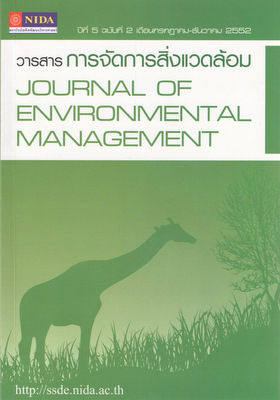ประสิทธิภาพของพุทธรักษาในการบำบัดน้ำเสียชุมชนโดยระบบบึงประดิษฐ์ แบบการไหลใต้ผิวในแนวดิ่ง Efficiency of Canna warscewiezii Dietr for Domestic Wastewater Treatment Using Subsurface System Constructed Wetlands
บทคัดย่อ
การศึกษาประสิทธิภาพของพุทธรักษาในการบำบัดน้ำเสียชุมชนโดยระบบบึง ประดิษฐ์แบบการไหลใต้ผิวดินเป็นการวิจัยแบบทดลองภายใต้สภาวการณ์ธรรมชาติ เพื่อศึกษาผลของความหนาแน่นของพุทธรักษาต่อประสิทธิภาพการกำจัดค่า BOD, SS และ TKN และการเปลี่ยนแปลงการเจริญเติบโตของพืช โดยใช้น้ำเสียชุมชนที่ยังไม่ได้ผ่านการบำบัด นำมาผ่านการดักไขมันและตกตะกอนก่อนเข้าระบบบึงประดิษฐ์แบบการไหลใต้ผิวดิน โดยแบ่งการทดลองเป็น3 ถัง ถังแรกเป็นถังควบคุม ถังที่ 2 ปลูกพุทธรักษาจำนวน 10 ต้น/ตารางเมตร และถังที่ 3 ปลูกพุทธรักษาจำนวน 20 ต้น/ตารางเมตร ในระยะเวลา 8 สัปดาห์ ผลการวิจัยพบว่า ถังที่มีความหนาแน่นของพุทธรักษาที่ต่างกันสามารถกำจัดค่า BOD, SS ไม่แตกต่างกัน แต่ถังที่มีความหนาแน่นของพุทธรักษา 20 ต้น สามารถกำจัดค่า TKN ได้ดีกว่าถังควบคุมอย่างมีนัยสำคัญทางสถิติที่ระดับ 0.05 และพุทธรักษาสามารถเจริญเติบโตได้ไม่แตกต่างกัน
This study was an experimental research using a natural condition aimed at investigating the effects of densities of Canna warscewiezii Dietr on the wastewater removal efficiency in terms of BOD, SS , and TKN removal. The untreated domestic wastewater was passed through oil trapping and sedimentation tanks before passed through the subsurface system constructed wetlands. The experiments comprised of the control(without plant), the wetland system with 10 plants per square meter, and the wetland system with 20 plants per square meter. It was found that all of the systems were inefficient in terms of BOD and SS removal. TKN was removed more effectively at the system with 10 plants per square meter. C. warscewiezii could possibly grow in the experiment. However, there was no different in growth change of the plants in all experiments.



